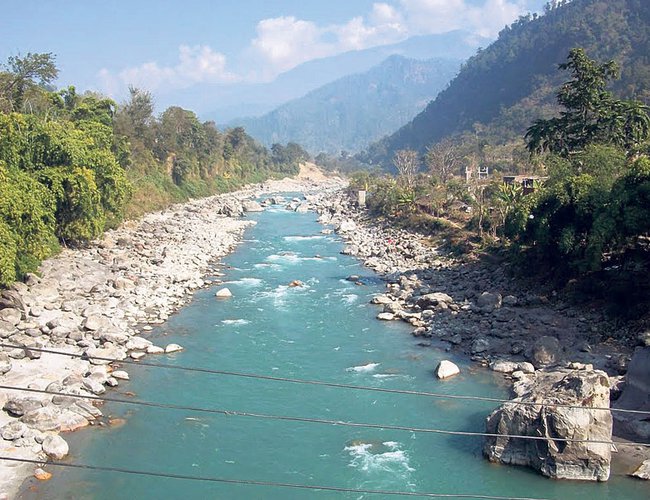
Budhigandaki hydropower project has always been on the forefront of controversy. Recently, a former Prime Minister of Nepal accused three other former Prime Ministers, two former and one current, of taking NRs. 9 billion as bribe to award its contract to a Chinese company. This has resurfaced the controversy on the US$2.5 billion mega reservoir based 1200 MW hydropower project. Out of the many hydropower project of Nepal, this particular one, whose site is located at Benighat, betweenGorkha and Dhading district (which is around 80 Km far from Kathmandu) is gaining more attention from both of our neighbors, India and China.
According to Mr.Hari Man Shrestha who have stated in his study, India showed its first interest in the project during the visit of Indian Prime Minister Mr. Chandra Shekhar during the 1990s. He states that during the joint meeting of the power ministry of Nepal-India, Indian side showed keen interest in developing survey and investigation of this project. As a response, the Nepalese side showed the prefeasibility study of the project which was conducted in 1984. This project was further discussed during theSecond Meeting of the Indo-Nepal Sub- commissionon Multiple Uses of Water Resources held in April1991.After that Nepalese Prime Minister Mr. Girija Prasad Koirala made an official visit to India, during which a joint team of experts were made. The joint team had even decided to start construction by 1994 and prepare a detailed project report (DPR) by 1992. The Indian team proposed that the additional investigation works and DPR would be financed by the Government of India (GOI) under a turnkey basis and a joint office would be opened in Nepal under GOI. The Nepalese team reassessed that regardless of the sources of financing, the project would be under the aegis of HMG/N (the then Nepal Government), since it is a Nepalese project. Hari Man Shrestha states that, “this point of contention recorded during the meeting became the reason to shelve the project until Dr. BaburamBhattarai’s government reinitiated talks to develop it”.
India can gain a lot if this project is made. However India cannot ignore the cost of making such big hydropower project. According to a report by Surya NathUpadhyaya and PrakashGaudel, if this project is made, a total of 1670.46 million cubic meter (MCM) of augmented water will be available annually during the dry season (October to May) which will be enough to irrigate some 80,000 ha of additional land in the downstream area in India. According to various estimates, India’s annual water demand will increase to 1,422 billion cubic meter (BCM) by 2050 and India needs 450 million tons of additional food to feed its growing population. In order to meet this requirements, water resources is very much important. The other benefits will be navigation benefit. The Government of India have plans to stretch 300 KM of ganga river from Hajipur to Bhaisalotan barrage which falls in the Gandak region. The reservoir upstream will help to channelize the water in the downstream gandak region.
India is not seen anywhere after the 1990s regarding this project. But the license awarded to the project always changes with the change of the government. This shows the geo political battle of India and China. The budhigandaki was shelved until Dr. BaburamBhattarai reinitiated talks and named it a national pride project. The Bhattarai government appointed French company Tractebel Engineering S.A with the overall objective to carry out necessary field investigation and upgrade the existing prefeasibility level study of the project to a feasibility level, prepare a detailed design and tender documents and tender drawings, and carry out environmental impact assessment, social impact assessment and prepare environmental management plan. After that the power generating capacity of the project was increased from 600 MW to 1200 MW. After that, the Pushpa Kamal Dahal (AKA Prachanda) led government hastily gave the license to China Gezhouba Group without competition bid. Soon after the Pushpa Kamal Dahal led government fall, the SherBahadurDeuba government cancelled the agreement with China Gezhouba Group to make the project citing procedural flaws. The Deuba government had initiated steps to make the project through domestic resources.The Deuba government had decided to provide NRs. 94 billion as viability gap funding (VGF) for the project. The VGF is around one third of the estimated cost of the project. However, it did not materialize after the Deuba government was replaced by KP Oli government during the general election in 2016. The present KP Oli led government (which is believed to be China friendly) had started initiation to rehire the Chinese group to start up the project, but nothing has materialized yet.

Pratik Poudel
Nepal Water Conservation Foundation
- Bridging Risk-Sensitive Land Use Planning and Farmland Abandonment: Policy Pathways for Disaster Risk Reduction and Resilience
- May 23, 2025
- Why More And More Youths Are Leaving Agriculture? Rational Economic Sense Or Something Else?
- Jul 01, 2024
- Why Upstream And Downstream Linkage In The River System Can’t Be Ignored?
- Feb 19, 2021
- How Can The Problems Of Koshi Region Be Addressed Through A Nexus Perspective?
- Nov 21, 2020
- Addressing Water Security In The South Asian Region Through Nexus Governance
- Sep 08, 2020












